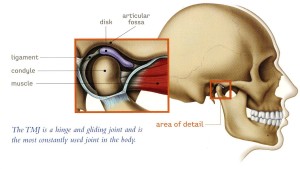Does anyone know how to resolve TMJ and Clenching Problems?
I would really like to tell you that there is an easy fix for the pain in your jaw, but that isn’t always true. While some cases go away by themselves over time, others continue to get worst.
TMJ is a disorder that can cause stress and pain to the temporomandibular joint and surrounding soft tissue.
With more that 15% of adults living with fascial pain, earaches and ringing, jaw pain and headaches, it may behoove the person suffering from this condition to try various methods to get the help they need. If you are experiencing any of the following symptoms while opening, closing or moving your mouth, or while sleeping or awakening in the morning, you may be in need of some support to restore and rebalance the positioning of the head, neck and mouth in relationship to healthy postural alignment throughout the body:
- difficulty opening and closing the mouth.
- jaw pain while yawning or chewing.
- pain or ringing in the ear area.
- hearing and/or feeling popping or clicking sounds.
- headaches.
- tenderness around the teeth and gum areas.
- teeth grinding
- jaws get stuck or locked.
- any swelling in the face
These are all common symptoms of what is know as TMD (Temporal Mandibular Disorders).
With a background focused mostly in Structural Integration and Craniosacral Therapy, I have found 5 things that seem to help clients improve and resolve this condition.:
- Myofascial Structural Therapy to improve how the head rests over the body.
- Craniosacral Therapy to improve movement within the sutures and to create balance in the cranium.
- Stretching and Movement Exercises. Not only are neck exercises crucial for improving neck posture, but also the pelvis needs to be freed up and symmetry between the legs established in order to help self-correct TMD. Some great options would be yoga, Feldenkrais, Continuum, gyro tonics and free dancing.
- See a dentist for a bite appliance. However, from a bodyworker perspective, I suggest one for the lower teeth rather than the top which is usually recommended. Wearing any type of appliance on the top that restricts movement of the maxilla only inhibits healthy movement of the cerebrospinal fluid.
- Meditation to reduce stress. The Central Nervous System Stress can play a big factor in mouth disorders by creating tension in the musculature. Letting go of stressful beliefs through inquiry (www.the work.com) or something like breathing exercises or a walk through nature can be very helpful.
- Explore options with your pillow. If you sleep on your back, you don’t need one. However, if you sleep mostly on your side, there are some nice posturepedic options available.
- SomatoEmotional Release helps clients to feel deeply into their bodies and let go of unhealthy energy patterns of stress.
Three things to avoid: Chewing gum and holding your cellphone in your neck. Stop slouching and find length in your spine while reading or sitting at a computer.
If you are in the local Columbus Ohio area, or would like a free 15 minute phone consultation, please feel contact me.
Sharon Hartnett CST, LMT, SI
(740) 966-5153


